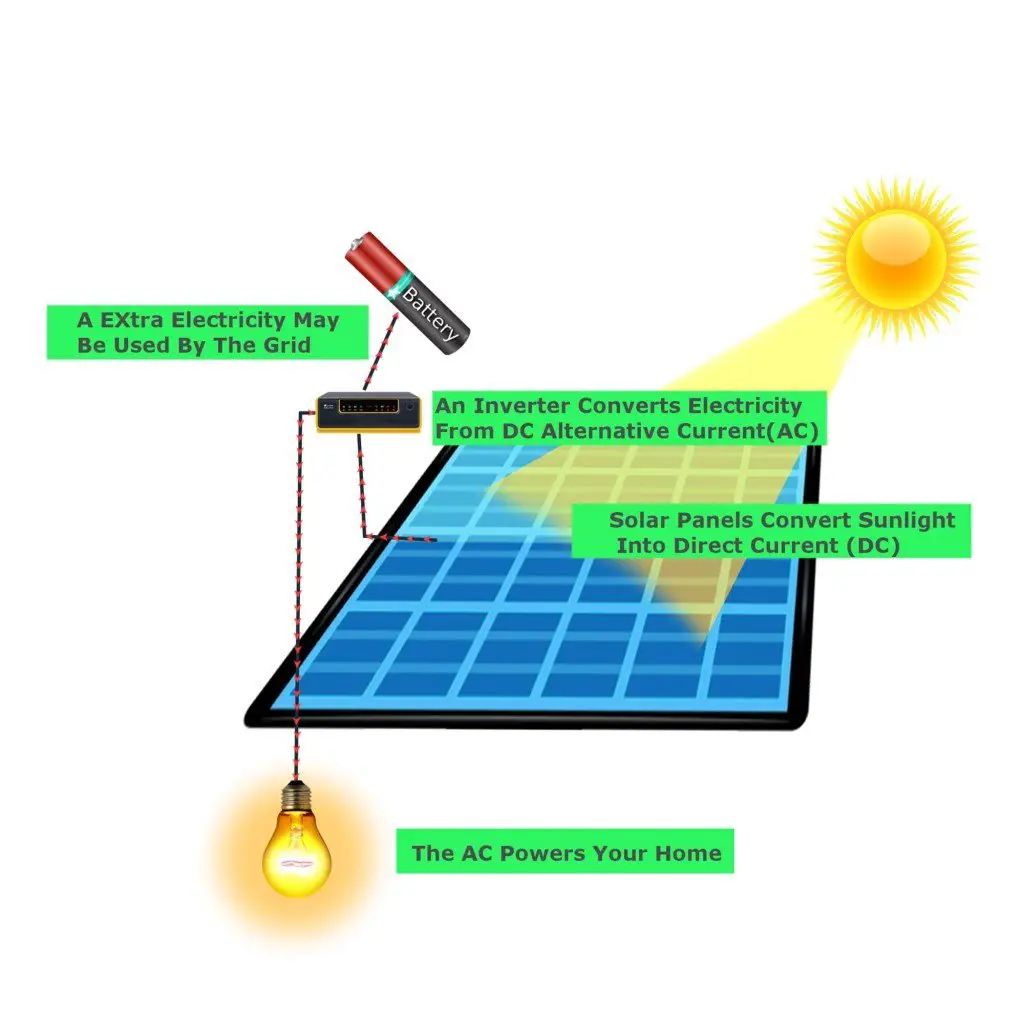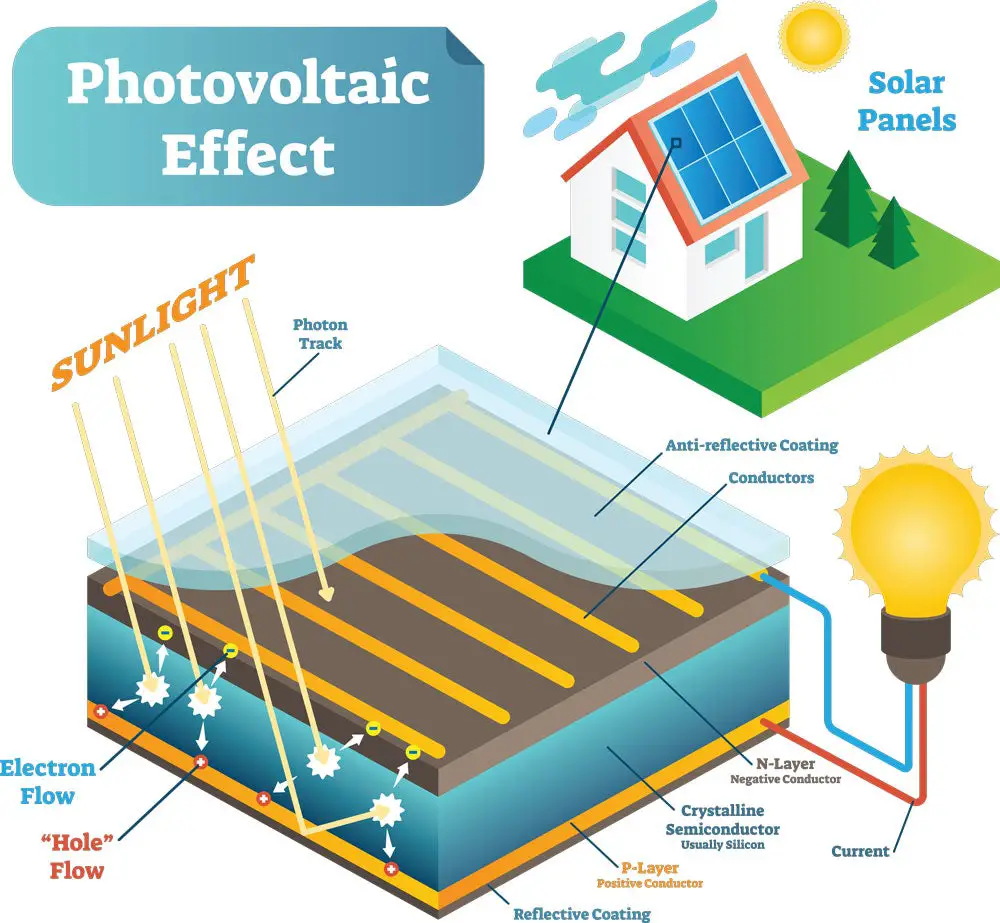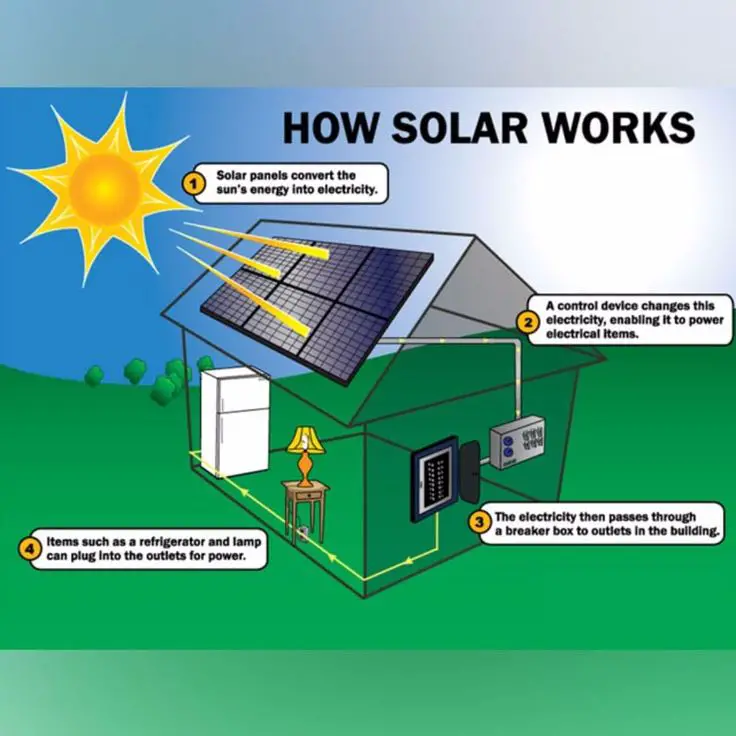What Are Solar Panels Made Of
Solar panels are made of a large number of solar cells electrically connected together. For home solar, there are usually 60 or 72 cells in each panel that measures about 5 ft. by 3 ft.
Silicon, glass, plastic, and metal are the four basic materials in 95+% of all residential solar panels you see on rooftops or mounted on poles in backyards.
Here is a diagram that shows the organization of layers in a solar panel:
: PV Education
Low-iron glass is the transparent protective cover of one-sided solar panels. It allows sunlight to pass through easily and hit the PV cells underneath. Glass is the backside, too, in bifacial solar panels.
An anti-reflective coating is commonly applied to the glass and/or the solar cells to minimize sunlight loss from reflection.
On the bottom is the backsheet. Its plastic or a combination of different plastics. Tedlar is a popular brand. Polyethylene terephthalate is also a common plastic used in the backsheet.
The backsheet may have an insulating layer to preserve internal wiring and an outer layer that protects the panel from weather.
On the back of a solar panel is the PV or module junction box. All wires attached to the solar panel in some way terminate here before they connect to your homes wiring. The junction box protects the wires from the weather. It is typically made of plastic.
Most panels are housed in aluminum metal frames that add durability.
What Is Solar Energy
Simply put, solar is the most abundant source of energy on Earth. About 173,000 terawatts of solar energy strike the Earth at any given time – more than 10,000 times the world’s total energy needs.
By capturing the sun’s energy and turning it into electricity for your home or business, solar energy is a key solution in combating the current climate crisis and reducing our dependence on fossil fuels.
Do Solar Panels Work On Cloudy Days
Contrary to popular opinion, solar panels work in most weather conditions, as the PV cells absorb both direct and indirect sunlight. In direct sunlight, they are at their most effective, but even on cloudy dull days, the sun is still producing energy. Rain clears the panels of dust and debris, keeping them operating efficiently. The energy generated from sunny days offsets the energy used on cloudy days or at night, making it a really efficient, sustainable system.
A battery can be added to your solar energy system to optimise its performance even more. They can increase efficiency by up to 50% and cost around £4,500 for an average home. If you plan to take advantage of the SEG scheme, a battery is a necessity to store the excess energy youve produced.
You May Like: Is There A Solar Storm Coming
How Does A Solar Panel Produce Energy
Solar panels are made up of many small units called solar cells. These solar cells are responsible for turning sunlight into electricity. A single panel can contain anywhere from 32 to 96 cells.
Each solar cell consists of two different layers of a naturally occurring element called silicon. One layer is composed of a positively-charged silicon while the other is negatively-charged silicon. When the two oppositely-charged layers are combined, an electric field is generated between them.
Now enter sunlight. Sunlight is essentially a stream of elements called photons. When a photon hits the solar cell, it can knock an electron loose from the atoms that comprise the silicon layers. The electric field between the two layers forces that extra floating electron to move toward the negatively-charged silicon layer.
Now imagine on a sunny day that a non-stop stream of photons pelts the solar panel. This means many electrons are knocked loose then all flow toward the same direction .
This constant, orderly flow of electrons iselectricity!
Do Solar Panels Work When Theres No Sunlight

The short answer is, no.
Solar panels might work on cloudy days but they wont be able to produce nearly as much electricity as they could during a day with full sunlight.However, solar panels tend to produce more power than you use up during a normal sunny day. If you have a solar battery, that extra electricity can be stored for use during nights or cloudy days.
Don’t Miss: How Do We Use Solar Energy
Solar : How Solar Energy Works
Have you ever looked at the solar panels on roofs and wondered exactly what they do, and how? Well, those hi-tech expanses of shimmering glass are actually just one component in a complex network that harnesses the suns renewable energy to deliver electricity to the home within.
Lets take a simple, step-by-step look at how solar power works.
Copper Indium Gallium Selenide
The most flexible, slim, and budget-friendly thin-film solar panel ever made is copper indium gallium selenide . CIGS is a type of thin film solar panel that is only a few micrometers thick. Copper indium gallium selenide substrate holds less toxicity than CdTe PV modules so they are best for the environment too.
CIGS is a type of thin film solar cell technology that has been around for a few decades, but its only recently seen significant growth. CIGS cells are made of thin layers of copper indium gallium selenide that offer good efficiency, high absorption, tandem design, and durability. High-quality commercial CIGS solar modules have efficiencies between 10% and 14%. And BougeRVs CIGS solar panel can reach 16%, which is a breakthrough in CIGS solar panels.
Read Also: Is Solar Power Worth The Investment
How Solar Panels Work: Principle Device Materials
Solar panels are considered a very efficient and environmentally friendly source of electricity. In recent decades, this technology has been gaining popularity around the world, motivating many people to switch to cheap renewable energy. The task of this device is to convert the energy of light rays into electric current, which can be used to power a variety of household and industrial devices.
The governments of many countries are allocating enormous amounts of budgetary funds, sponsoring projects that are aimed at developing solar power plants. Some cities make full use of electricity obtained from the sun. It is worth noting that the principle of operation of solar panels for homes is quite complex. Next, lets consider in detail how solar panels for the house work.
Step : Sunlight Activates The Panels
Each individual panel is constructed of a layer of silicon cells, a metal frame, a glass casing surrounded by a special film, and wiring. For maximum effect, the panels are grouped together into arrays and placed on rooftops or in large outdoor spaces. The solar cells, which are also referred to as , absorb sunlight during daylight hours.
Read Also: Where Are Sunrun Solar Panels Made
The Science Behind Solar Pv Cells
Solar PV panels are comprised of many small photovoltaic cells photovoltaic meaning they can convert sunlight into electricity. These cells are made of semi-conductive materials, most often silicon, a material that can conduct electricity while maintaining the electrical imbalance needed to create an electric field.
When sunlight hits the semiconductor in the solar PV cell the energy from the light, in the form of photons, is absorbed, knocking loose a number of electrons, which then drift freely in the cell. The solar cell is specifically designed with positively and negatively charged semiconductors sandwiched together to create an electric field . This electric field forces the drifting electrons to flow in a certain direction- towards the conductive metal plates that line the cell. This flow is known as an energy current, and the strength of the current determines how much electricity each cell can produce. Once the loose electrons hit metal plates, the current is then directed into wires, allowing the electrons to flow like they would in any other source of electric generation .
As the solar panel generates an electric current, the energy flows through a series of wires to an inverter . While solar panels generate direct current electricity, most electricity consumers need alternating current electricity to power their buildings. The inverters function is to turn the electricity from DC to AC, making it accessible for everyday use.
Do Solar Panels Work On Rainy Days And During Night
Solar panels do work in the rain and during cloudy days. However, their production is low, 70% to 80% lower than on an average sunny day.
For example, if your 1kW solar system is producing 4kWh per day regularly, this could go down to 0.8kWh in the worst weather.
As for the night, solar panels do not produce electricity at all because moonlight carries very low energy, so low that panels cannot convert it into usable energy.
Solar energy from the moonlight is 400,000 times lower than sunlight.
Related Reading: Do Solar Panels Work At Night?
Don’t Miss: How Much Does It Cost For Tesla Solar Panels
How Much Energy Does A Solar Panel Produce
Have a look in the table below for a few more examples of how much energy different amounts of solar panels could produce.
| Size of panel | |
| 17 panels | 6.205kW |
Note that if the proposed peak output of your system is greater than 4.68kW, then you will need to get the installation approved by your local District Network Operator . If you book an installation with us, well submit the application for you! If you need to make the application yourself, you can find your DNO here.
Super Flexible And Lightweight

CIGS solar panels are super light. They are thin and flexible. The panels can be bent and twisted to fit any shape. And usually, they don’t need a frame like traditional solar panels.
The CIGS panels can be folded and wrapped for any outdoor activity or an RV trip along the riverside. A 100W Flexible Solar Panel by BougeRV has strong potential to charge your mobile devices, laptop, or mini electronic gadgets abandoned outdoors, without a utility supply.
Also Check: Can I Have Solar Panels On My House
How Do Solar Panels Work On Homes
Solar panels in a home are tied to a grid. While the sun is shining, solar power is captured by the panels and converted into electricity. Solar energy works when the photons of an atom knock the electrons free from atoms in the panel, generating electricity flow. When solar panels are installed on your roof and begin to produce energy, it first must be converted into the type of power your home can use.
Originally the solar energy was converted into direct current electricity. However, for your home to use it, the electricity must be converted into electricity, the power your home uses. This is the job of the solar inverter installed alongside your panels. The inverter changes the DC energy into AC electricity that your home can use. Solar panels cannot generate electricity at night once the sun has gone down, and that is when your family will need to draw power from the grid.
How Does The Energy Get To Your Home
First off, a single solar cell can produce roughly .5 volts, which isnt much power at all. However, a solar panel with 36 solar cells in total can produce ~17 volts. When you have several solar panels all creating electricity at the same time, you now have a good amount of electricity being produced.
But how does that energy find its way into your home?
Wiring runs through a solar panel to capture and collect the electricity produced by each solar cell. From there, the wire directs all of that newly-produced electricity into an inverter. This inverter transforms the DC or direct current electricity into AC or alternating current electricity, which is the type of electricity that your homes appliances need.
Once the electricity is transformed into AC current, it travels along more wiring until it reaches your homes electrical panel. From there, the electrical panel feeds that electricity throughout your home to power your appliances.
You May Like: Best Solar String Lights For Outdoors
Why May Solar Panels Not Work
Youve installed your solar panels but the system just doesnt seem to generate any energy. What can you do?
Unfortunately this problem known as zero power output can be caused by a damaged inverter, faulty charge controller or simply your solar panels not working.
Check if your inverter is up and running. This works as a power adapter and is crucial to converting the energy of the sun into a format home appliances accept.
If it still doesnt work after inspecting the inverter, youll have to contact the company that supplied it. Do the same with your charge controller.
Other reasons include nearby trees casting a shadow on your solar panels when the sun is out and your system overheating this can be fixed by connecting extra modules.
Winter Clouds And Snow: Do Panels Still Work
Solar panels work at all times throughout the year, even in winter. Your panels will even produce electricity when it is cloudy, though output is significantly reduced. There is a strong correlation between sunlight hours and solar output, so naturally, panels produce less electricity in the winter months. Not even snow can defy solar panels provided they are installed at a tilt, snow simply slides off the panels when it melts.
You May Like: Does A Sole Proprietor Need A Registered Agent
What Works Better Than Solar Panels
It is more efficient to use wind than it is to use solar. Compared to solar panels, wind turbine releases less CO2 to the atmosphere, consumes less energy, and produces more energy overall. The amount of electricity generated by a wind turbine is the same as the amount of electricity generated by a solar panel.
Install A Pv Diverter
PV diverters are a low-cost and low maintenance option for increasing your own consumption of solar electricity .
Most of the time your solar PV system either:
Instead of sending surplus electricity to the grid, a PV diverter switch can power the immersion heater in your hot water tank, storing hot water for you to use later. On its own, excess solar energy is unlikely to meet all your hot water needs, but it can help reduce your bills.
A PV diverter switch installation could add around £800 to your installation costs.
If youre interested in using PV diverter, speak with your installer. They might also suggest increasing the number of panels on your roof to provide more electricity for your hot water needs.
You could also export the excess electricity to the grid and consider applying for export payments via a Smart Export Guarantee.
Other options for renewable hot water include solar water heating, or fitting a whole-house heating system such as a heat pump or biomass boiler.
You May Like: Does Pine Sol Deter Rodents
How Solar Cells Work
Solar cells mix with other components like phosphorus and boron to form two parts: one loaded with negative electrons and another with positive electrons.
When the solar cell is exposed to the sun, the photons are able to move electrons from the part where the negative charge is in excess toward the part where it is missing. This movement of electrons is what we know as electrical current.
As the photons release electrons, more and more electricity is generated. The electrons that are not used or that come from the wind return to the negative panel, making everything start again in an endless process.
With that, continuous current is produced, which is stored in batteries until being converted into alternate current through the voltage inverters.
Take a minute to find the product that best suits you:
Benefits Of Solar Panels

Now you know what they are and how they work, we can tell you why to care.
- Renewable energy source: Solar energy is accessible for as long as we have the sun, which scientists reckon will be at least five billion years. Its truly a renewable energy source, doesnt produce gases, pollute water or create noise. Its a green dream.
- Reduces electricity bills: Since youll be generating some of your energy needs from solar panels, your total electricity bills will drop. You can also make money by selling any unused electricity back to the grid. And you can still switch gas and electricity suppliers when you have solar panels.
- Timing: Household energy usage needs tend to be higher in the afternoon and evenings, when people are at home. This is perfect as solar energy reaches maximum production around those times. Note: solar panels dont work at night.
- Low maintenance: Solar panels dont require much maintenance just cleaning a few times a year. Warranties are usually for 20-25 years and the inverter only needs to be changed after 10 years.
You May Like: Can You Wash Solar Panels
Easy Installation And Maintenance
Emmer also believes that solar panels are an attractive option because of just how simple they are to install in ones home, as well as how easy they are to maintain. Solar panels virtually eliminate the headache and hassle that comes with hazardous gas leaks, or boilers that break down, just to name a couple of the obstacles that utilizing these more costly electrical sources pose for homeowners.
On the contrary, with solar panels Emmer points out that, Service is only required when something isnt functioning correctly. General upkeep, such as cleaning your solar panels, is recommended at least once per year. He adds, Solar panels are generally very low-maintenance, so there is very little to worry about in terms of adding and using solar panels to your home.
Compare Quotes From Top-rated Solar Panel Installers
Select a State To Get Started With Your No Commitment, Free Estimate